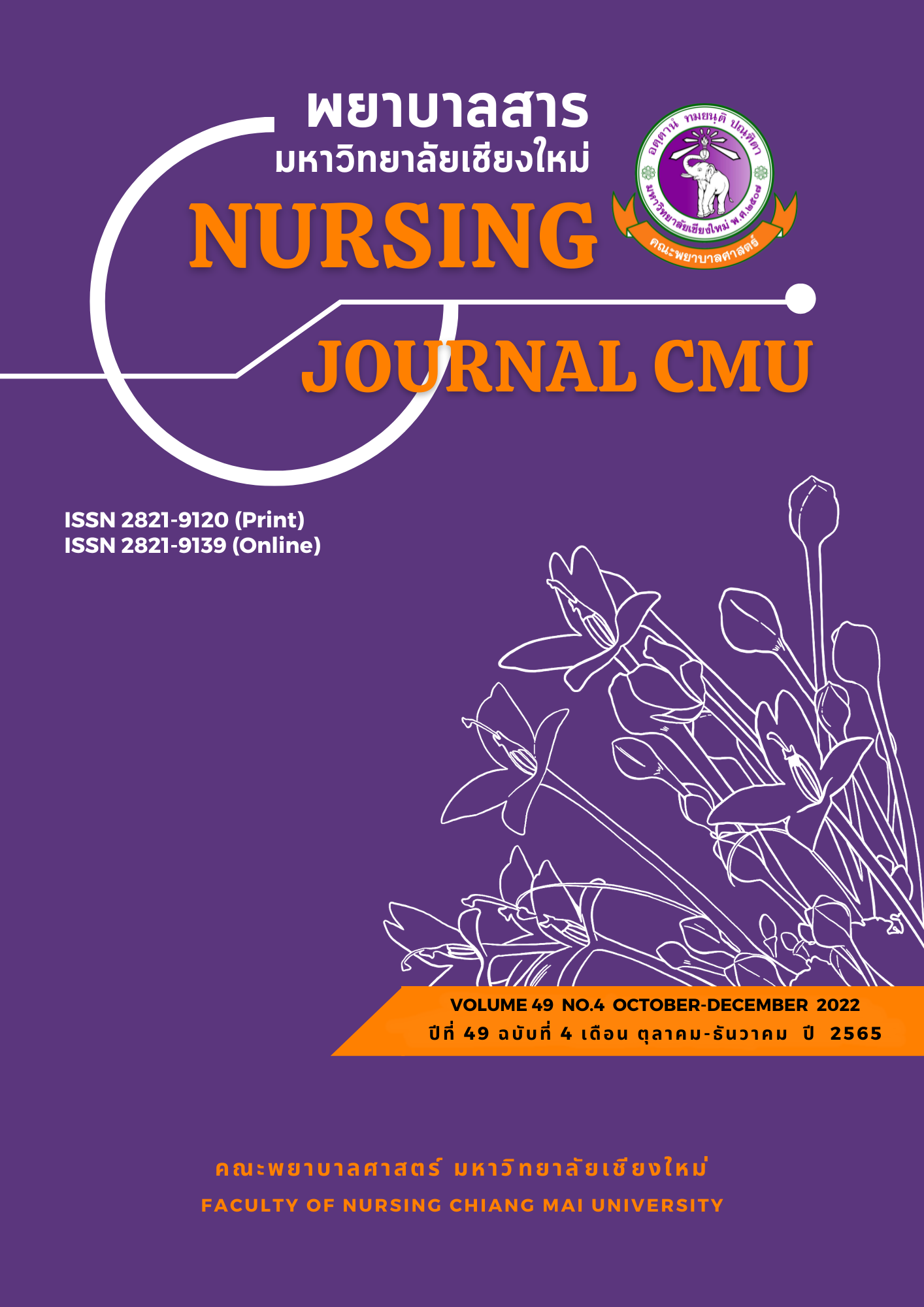Critical Care Knowledge of Nurses Working in Surgical Intensive Care Units in the 4th Public Health Region
Keywords:
Surgical intensive care unit, Critical care knowledge, Intensive care unit nursesAbstract
Surgical intensive care unit nurses must have sufficient knowledge of critical care patients as well as the capacity to make correct decisions and provide nursing care so that patients receive accurate and timely treatment. This descriptive research aimed to study nurses' knowledge in caring for critically ill patients. The samples consisted of 182 ICU nurses who had at least six months’ experience, or more, working in an intensive care unit in nine hospitals in the 4th Public Health Region. The data collection instruments consisted of 1) a demographic data form, and 2) the Knowledge Regarding Critical Care Nursing (QKCCN) questionnaire. The QKCCN has 12 sub-scales, which were developed from a review of the relevant literature by applying the Basic Knowledge Assessment Tool (BKAT-3) with a study of the university's nursing curriculum on critical care defined by the Nursing Council. The QKCCN was validated by a panel of 5 experts and exhibited validity by CVI (0.99) and reliability coefficient by KR-20 (0.72). The data were analyzed using descriptive statistics.
The study discovered that ICU nurses had a moderate level of knowledge in caring for critically ill patients. The average percentage of correct answers of the participants was 79.96%. Considering the average percentage of participants’ correct answers for each aspect, it was found that the first three aspects of critical care knowledge for which the participants had the least knowledge were: 1) caring for trauma, burns, and scalds (71.0%); 2) caring for hemodynamic monitoring lines (72.75%); and 3) caring for the respiratory system (72.80%).
The results of this study can be used as basic information to promote and develop specific knowledge for nurses in intensive care units in order to have sufficient knowledge and be able to take care of patients more effectively.
References
Akın Korhan, E., Hakverdioğlu Yönt, G., Parlar Kılıç, S., & Uzelli, D. (2014). Knowledge levels of intensive care nurses on prevention of ventilator associated pneumonia. Nursing in Critical Care, 19(1), 26-33.
Alastalo, M., Salminen, L., Vahlberg, T., & LeinoKilpi, H. (2020). Knowledge of patient observation among critical care nurses. Nursing in Critical Care, 26(5), 341-351.
Almarhabi, M., Cornish, J., & Lee, G. (2021). The effectiveness of educational interventions on trauma intensive care unit nurses’ competence: A systematic review and meta-analysis. Intensive and Critical Care Nursing, 64, 102931.
Asfour, H. I. (2016). Fluid balance monitoring accuracy in intensive care units. IOSR Journal of Nursing and Health Science, 5(4VI), 53-62.
Bankanie, V., Outwater, A. H., Wan, L., & Yinglan, L. (2021). Assessment of knowledge and compliance to evidence-based guidelines for VAP prevention among ICU nurses in Tanzania. BMC Nursing, 20(1), 1-12.
Basar, Z., & Cilingir, D. (2019). Evaluating ethical sensitivity in surgical intensive care nurses. Nursing Ethics, 26(7-8), 2384-2397.
Bloom, B. S. (1956). Taxonomy of educational objectives: The classification of educational goals. Handbook I: Cognitive domain. New York: David McKay.
Bloomer, M. J., Fulbrook, P., Goldsworthy, S., Livesay, S. L., Mitchell, M. L., Williams, G., & Friganovic, A. (2019). World federation of critical care nurses 2019 position statement: Provision of a critical care nursing workforce. Connect: The World of Critical Care Nursing, 13(1), 3-7.doi: 10.1891/1748-6254.13.1.3
Chowdhury, S., Almarhabi, M., Varghese, B., & Leenen, L. (2022). Trauma resuscitation training: An evaluation of nurses' knowledge. Journal of Trauma Nursing, 29(4), 192-200.
Getahun, A. B., Belsti, Y., Getnet, M., Bitew, D. A., Gela, Y. Y., Belay, D. G., … Diress, M. (2022). Knowledge of intensive care nurses towards prevention of ventilator-associated pneumonia in North West Ethiopia Referral Hospitals, 2021: A multicenter, cross-sectional study. Annals of Medicine and Surgery, 78, 103895.
Kuakarun Faculty of Nursing, N. U. (2021). Program of nursing specialty in critical care nursing adult and elderly. Retrieved from https://www.kcn. ac.th/ storage/app/ media/ document/curriculum/18.pdf
Kumkong, M., Chotibun, P., & Singsri, T. (2020). Registered nurses competencies in caring patents with quality and safety. EAU Heritage Journal Social Science and Humanities, 10(2), 183-193. (in Thai)
Liu, S. I., Curren, J., Leahy, N. E., Sobocinski, K., Zambardino, D., Shikar, M. M., … Winchell, R. J. (2019). Trauma response nurse: Bringing critical care experience and continuity to early trauma care. Journal of Trauma Nursing, 26(4), 215-220.
Ozen, N., & Armutçu, B. (2018). Knowledge levels of critical care nurses on evidence-based practices for the prevention of ventilator-associated pneumonia. Journal of Medical and Surgical Intensive Care Medicine, 9(3), 78-83.
Papadimitriou-Olivgeris, M., Panteli, E., Koutsileou, K., Boulovana, M., Zotou, A., Marangos, M., & Fligou, F. (2021). Predictors of mortality of trauma patients admitted to the ICU: A retrospective observational study. Brazilian Journal of Anesthesiology, 71, 23-30.
Srisatidnarakul, B. (2010). The methodology in nursing research. Bangkok: U & I Intermedia. (in Thai)
Thai strive road safety culture for road safety citizens. (2022). Road accident statistics. Retrieved from http://www.thairsc.com/
Toth, J. C. (1986). The Basic Knowledge Assessment Tool (BKAT)—validity and reliability: A national study of critical care nursing knowledge. Western Journal of Nursing Research, 8(2), 181-196.
Uzman, S., Yilmaz, Y., Toptas, M., Akkoc, I., Gul, Y., Daskaya, H., & Toptas, Y. (2016). A retrospective analysis of postoperative patients admitted to the intensive care unit. Hippokratia, 20(1), 38.
Yoosook, S. (2017). Developing a model of care for the multiple trauma hypovolemic shock patients in Sawanpracharak Hospital. Journal of Department of Health Service Support, 13(2). (in Thai)
Downloads
Published
How to Cite
Issue
Section
License
Copyright (c) 2022 Nursing Journal

This work is licensed under a Creative Commons Attribution-NonCommercial-NoDerivatives 4.0 International License.
บทความที่ได้รับการตีพิมพ์เป็นลิขสิทธิ์ของวารสารพยาบาลสาร
ข้อความที่ปรากฏในบทความแต่ละเรื่องในวารสารวิชาการเล่มนี้เป็นความคิดเห็นส่วนตัวของผู้เขียนแต่ละท่านไม่เกี่ยวข้องกับมหาวิทยาลัยเชียงใหม่ และคณาจารย์ท่านอื่นๆในมหาวิทยาลัยฯ แต่อย่างใด ความรับผิดชอบองค์ประกอบทั้งหมดของบทความแต่ละเรื่องเป็นของผู้เขียนแต่ละท่าน หากมีความผิดพลาดใด ๆ ผู้เขียนแต่ละท่านจะรับผิดชอบบทความของตนเองแต่ผู้เดียว






